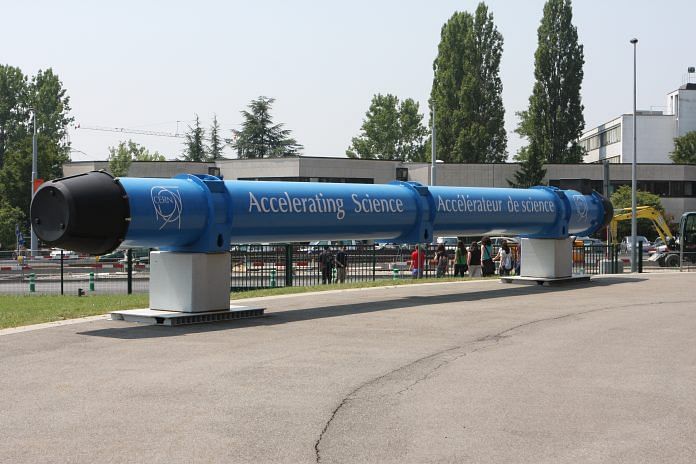Belfast, Northern Ireland: Travelling back in time to witness the origin of the universe and diving deep into the human body to count the exact number of particles you’re made of. Science can be fun, and one of the world’s premier research organisations is dispatching a travelling exhibit to India this month to show just how.
For the first time ever, the Geneva-based European Organisation for Nuclear Research, better known as CERN, is bringing its flagship travelling exhibition ‘Accelerating Science’ to India, which will be on show across four cities till March 2020.
The offerings include a glimpse of the Big Bang, a microscopic look at the tiniest building blocks of the human body, and a close encounter with breakthrough projects of modern science, including LIGO, which helped detect gravitational waves for the first time in 2015, and the Large Hadron Collider (LHC), which helped find the Higgs boson or “god particle”, considered critical to understanding how matter attains mass, in 2012.
“India and CERN have enjoyed a fruitful partnership since the 1960s,” said Dr Charlotte Warakaulle, director of International Relations, CERN.
“India has over the past decades made many important contributions to CERN accelerators, experiments and IT infrastructure, reflecting a strong tradition in science and technology innovation, which has now been consolidated with India’s associate membership of CERN since 2017,” she added.
Finding the ‘god particle’
CERN was at the forefront of efforts to detect the Higgs boson, which is named after two stalwarts of theoretical physics: Nobel laureate Peter Higgs, who theorised the “existence of a particle that explains why other particles have a mass” 48 years before the particle was discovered, and Satyendranath Bose for the ‘Bose-Einstein statistics’ he derived in collaboration with Albert Einstein.
The detection of the Higgs boson remains one of the most pathbreaking discoveries in fundamental science.
In simple terms, Higgs boson is a fundamental particle predicted by a theory called Standard Model that unifies three fundamental forces.
This particle is known to create a Higgs field which gives mass to all the matter we see around us. Because mass is so fundamental and innate to our existence, media began to refer to the Higgs boson as ‘god particle’.
This particle was found using high-energy experiments at the LHC, the world’s largest and more powerful particle accelerator.
Also read: A bigger Hadron Collider can wait & the money put in other scientific endeavours
Soft diplomacy
The fundamental objective of the science exhibition, ‘Vigyan Samagam’, is to highlight India’s role and contributions to the world’s biggest science projects.
It also aims to highlight the value and impact of international collaborations and the power of soft diplomacy with other scientifically advanced nations.
The Permanent Mission of India to Conference on Disarmament, the nodal agency for CERN-India affairs, took the lead in organising it.
‘Vigyan Samagam’ is jointly funded by the Department of Atomic Energy (DAE) and the Department of Science & Technology (DST).
It will feature live working models of seven breakthrough science projects, including the LHC and LIGO.
To encourage research
The exhibition will spend approximately two months each in four cities — Mumbai, Bengaluru, Kolkata and Delhi — between May 2019 and March 2020. The idea is to inspire and motivate thousands of students into a career in science and research.
Events around the exhibition include talks by subject experts associated with each of these mega science projects, interaction with top Indian scientists, and industry-sponsor booths.
“As CERN enters an exciting new phase with an ambitious upgrade of… the Large Hadron Collider, we are privileged to have India as part of our global scientific endeavour,” Dr Warakaulle said.
“We look forward to showcasing this valuable cooperation during the exhibition across India,” added Dr Warakaulle, who acts as a global science ambassador at CERN.
You can catch them at:
- Nehru Science Centre, Mumbai – 8 May to 7 July 2019
- Visvesvaraya Industrial & Technological Museum, Bengaluru – 29 July to 28 September 2019
- Science City, Kolkata – 4 November to 31 December 2019
- National Science Centre, Delhi – 21 January to 20 March, 2020
For more details & updates visit here.
Dr Aswin Sekhar is an Indian scientist and science writer




Nice ! I wonder what will hapen when they reach goal… as Shiva is there …will they also become destroyer as she is,and make black hole or just something less crazy…like opening portal to other dimension ….inviting entities and demons into this one…. so curious